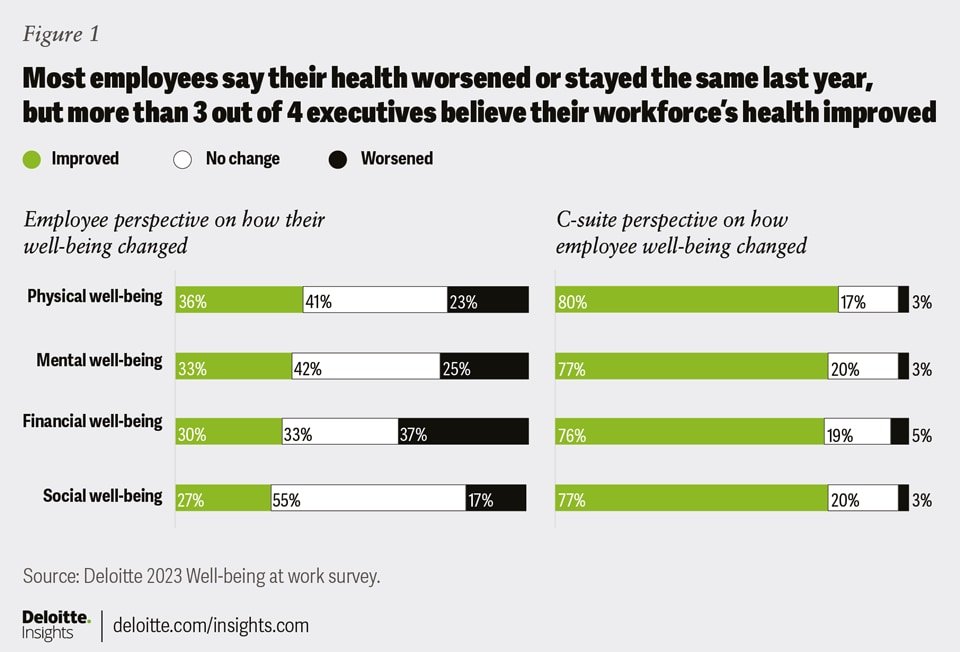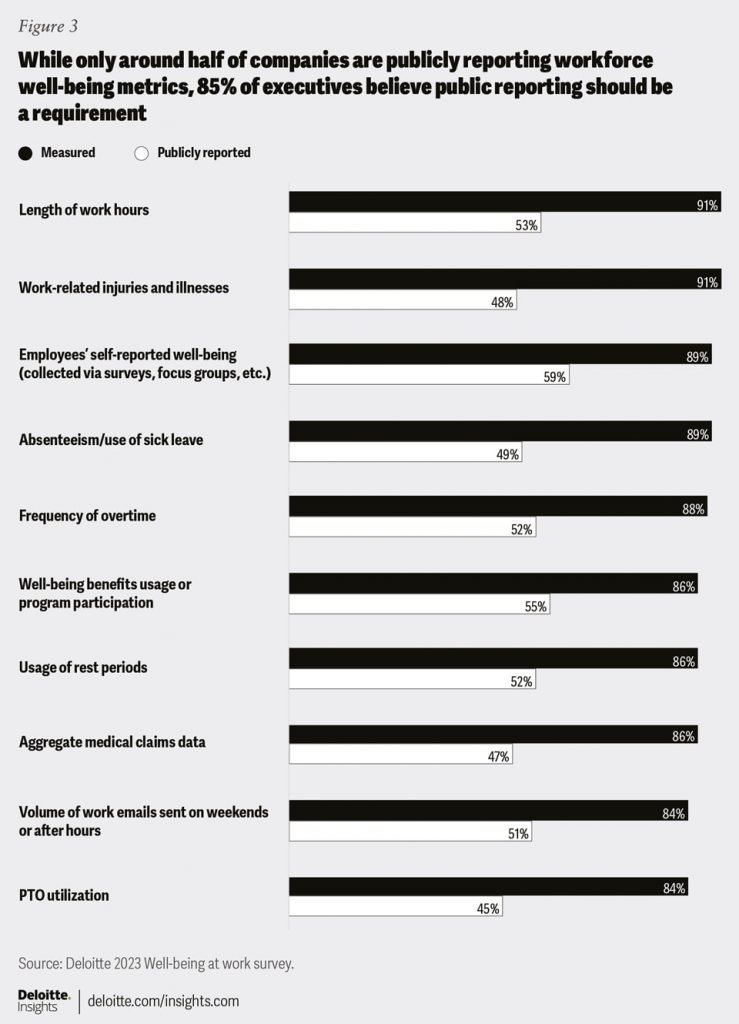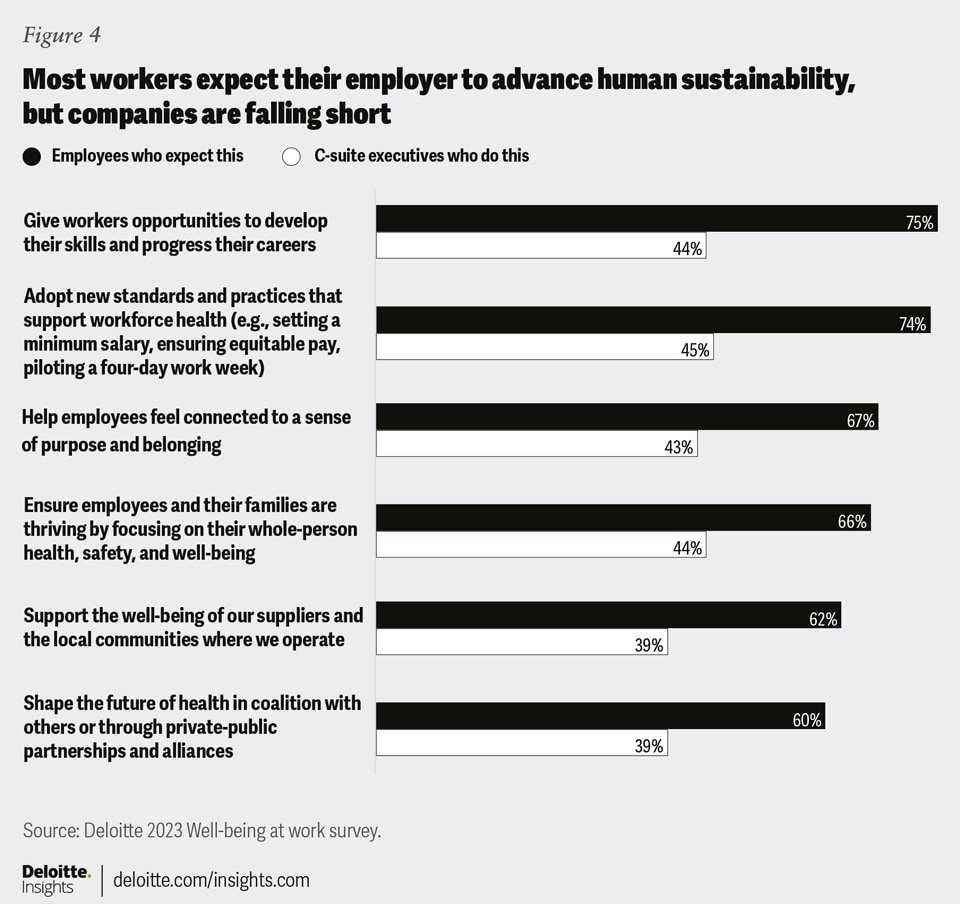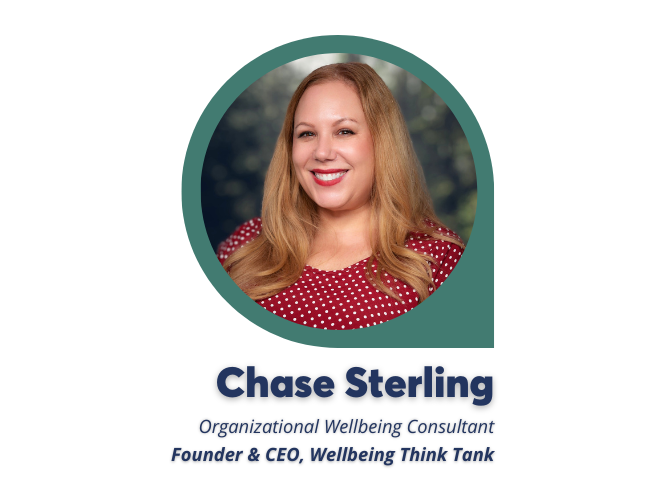Deloitte’s recent Well-Being at Work survey uncovered a stark reality: employees are still struggling with unacceptably low levels of well-being. Even more alarming is that these levels have further deteriorated since last year, emphasizing the need for immediate action.
This article examines the survey’s results, identifies areas where employers are lacking, and presents potential solutions for a brighter future.
Pressed for time? Here’s a quick summary…
- There is a disconnect between executives’ optimistic perception of employee well-being and the reality of its poor state.
- Many employees cite work-related factors as the primary obstacles to achieving overall well-being.
- Managers can become catalysts of employee well-being when provided with proper training, support, and encouragement.
- Publicly reporting workforce well-being metrics and commitments can enhance employee trust and attract top talent.
- A focus on human sustainability can create long-term value for individuals, organizations, and society at large.
The Deteriorating State Of Workforce Well-Being
While employees have expressed a strong desire to improve their well-being, actual progress has proven to be challenging. Self-reported well-being indicators have declined across all dimensions compared to last year, with less than two-thirds of workers rating their physical (63%) and mental (58%) well-being as “excellent” or “good.” The figures are even lower for social (45%) and financial (35%) well-being.
While most employees believe their well-being either worsened or remained the same, a strikingly high proportion of executives—over three-quarters—inaccurately perceive an improvement in their workforce’s well-being. This disconnect highlights a prevailing lack of awareness among leaders regarding the actual state of their team’s state of health.

Many employees perceive their job as the primary obstacle to achieving overall well-being, with 80% of survey respondents encountering work-related hurdles. Significant job responsibilities and expectations, work-related stress, and long hours topped the list of employee concerns.
Consequently, workers find it challenging to prioritize their well-being and establish healthy behaviors, particularly those related to their job. Many employees struggle to take time off or disconnect from work (74%), exercise regularly (48%), take breaks (47%), get sufficient sleep (45%), and spend ample time with friends and family (42%).
Given these findings, it’s not surprising that there has been a notable increase in the number of employees and executives considering leaving their current positions for jobs that prioritize well-being. Sixty percent of employees and 75% of the C-suite report contemplating a job change, compared to 57% and 69% last year, respectively. Managers also express a strong desire to switch jobs in pursuit of improved well-being (64%).
3 Ways To Enhance Workforce Well-Being
As these statistics continue trending in the wrong direction, the urgency for organizations to turn the tide has never been more pressing.
Managers: Custodians Of Well-Being
Managers play a crucial role in fostering workforce well-being. However, a relatively low percentage of managers actively support their teams:
- 54% check in with employees about their well-being.
- 48% ensure employees’ workloads are manageable.
- 47% encourage employees to take breaks during the day.
- 38% promote wellness benefits offered to employees.
- 37% encourage employees to use their paid time off and take necessary breaks from work.
- 35% communicate openly about their well-being with employees.
- 30% model healthy habits.
- 26% lead team wellness challenges or activities.
Despite the overwhelming consensus among managers (96%) and employees (94%) that managers should bear some responsibility for their employees’ well-being, organizational obstacles prevent them from fulfilling this role effectively. Seventy percent of managers cite rigid scheduling requirements, heavy workloads, unsupportive workplace cultures, and a lack of necessary skills as barriers. Less than half of managers feel completely capable of helping their company achieve its well-being commitments.
To support and empower managers to become catalysts of well-being, organizations must take key actions such as:
- Providing managerial training to support employees and promote well-being effectively;
- Aligning workloads and policies with well-being behaviors;
- Encouraging managers to open the lines of communication about well-being; and,
- Increasing managerial engagement with wellness programs and initiatives to model healthy behaviors.
These measures have positive implications for both workforce well-being and employee engagement. Managers with high well-being are more than twice as likely to be engaged at work, creating a trickle-down effect on their team members. Employees working under an actively engaged manager are 59% more likely to be engaged themselves compared to those supervised by a disengaged manager.
Key Takeaway: Employers must proactively support managers in their role as wellness advocates. With the right resources and encouragement, managers can be instrumental in driving both employee well-being and engagement, creating a more productive and healthy work environment.
Executive Transparency In Well-Being Metrics
Executives are increasingly acknowledging their responsibility for fostering workforce well-being, with:
- 85% intending to become more responsible for workforce well-being in the next one to two years;
- 72% believing that executives’ bonuses should be tied to well-being metrics; and,
- 78% believing that leadership changes should be implemented if their company cannot maintain an acceptable level of well-being.
These findings underline a pressing need for clear metrics, regular monitoring, and board-level discussions on workforce well-being.
While 85% of executives think organizations should publicly report their workforce well-being metrics, only about half of the surveyed leaders indicate that their company does so.

This discrepancy emphasizes the need for organizations to embrace public reporting tactics. Transparent leadership communication, not just support, can greatly impact employee well-being and foster trust between employees and organizations.
Metrics and wellness commitments should be public and widely communicated. Many employees are unaware of their company’s well-being offerings. Closing this gap can be achieved through communication channels such as social platforms, internal channels, and meetings.
Sharing these goals publicly could also be a game-changer for attracting new talent. Eighty-seven percent of executives agree that candidates would be more likely to accept a position with a company if its leaders have made public commitments around workforce well-being.
Key Takeaway: Executives’ growing focus on clear communication and public dedication to employee wellness signals a shift towards greater corporate accountability. Employers that actively embrace these ideas not only improve their workplace environment but also become more appealing to prospective employees.
Human Sustainability: A New Path Forward
The concept of human sustainability offers a promising approach to addressing the workforce well-being crisis. Human sustainability focuses on creating long-term value for individuals, organizations, and society at large. It can enhance employees’ health, skills, and sense of purpose.
While 89% of executives believe their companies are advancing human sustainability, only 41% of employees share the same perception.

To enhance these human sustainability initiatives, organizations can consider:
- Aligning their actions with global frameworks like the United Nations’ Sustainable Development Goals and Environmental, Social, and Governance standards;
- Participating in executive training programs focused on human sustainability; and,
- Working with human sustainability experts.
While company-led efforts are crucial to drive progress, achieving long-term human sustainability requires a broader approach. The notion of well-being economies, where countries prioritize citizens’ quality of life instead of relying solely on economic indicators, has gained traction. Over three-quarters of respondents believe more countries should embrace this concept, and a vast majority of executives say they would choose their next career or even relocate based on a company’s commitment to advancing human sustainability.
Key Takeaway: To bridge the gap between leadership and employee perceptions of human sustainability initiatives, companies must prioritize transparent action, including adopting global standards and continuous learning. This holistic approach is key to appealing to professionals in the shifting societal landscape valuing the quality of life.
Forging A Path To A Brighter Future In Workforce Well-Being
The current state of workforce well-being represents a significant turning point for organizations. It is a call for leaders to step up, embrace accountability, and empower their managers to prioritize employee health. By taking proactive measures to enhance well-being and adopting a focus on human sustainability, companies can redefine the narrative surrounding workforce health – within and beyond organizational walls.












